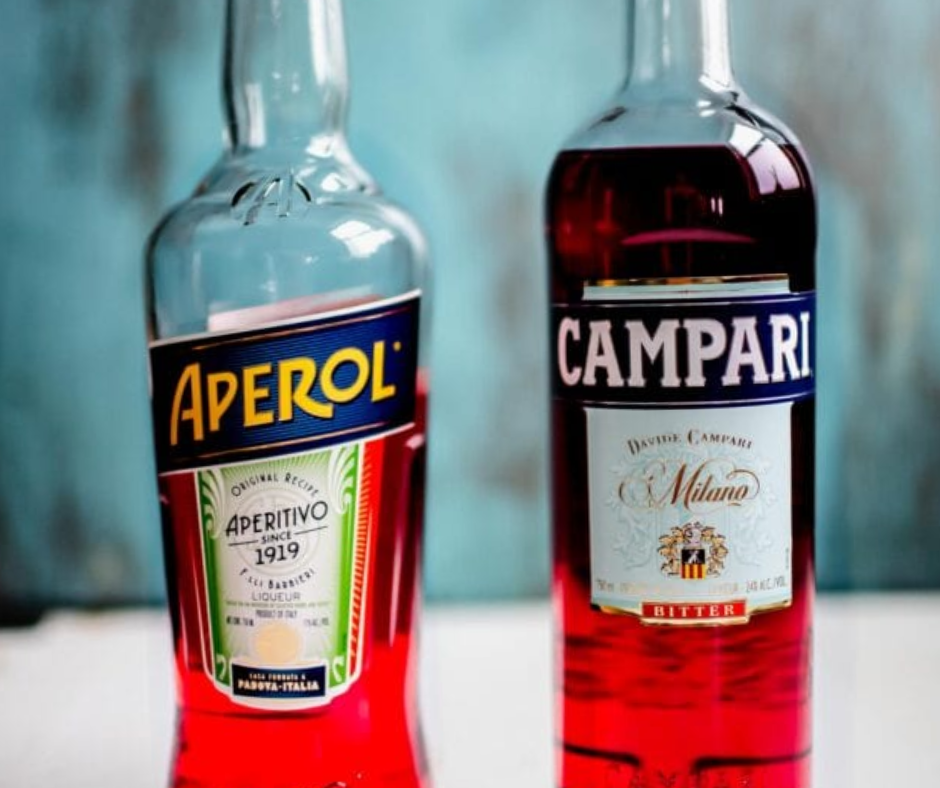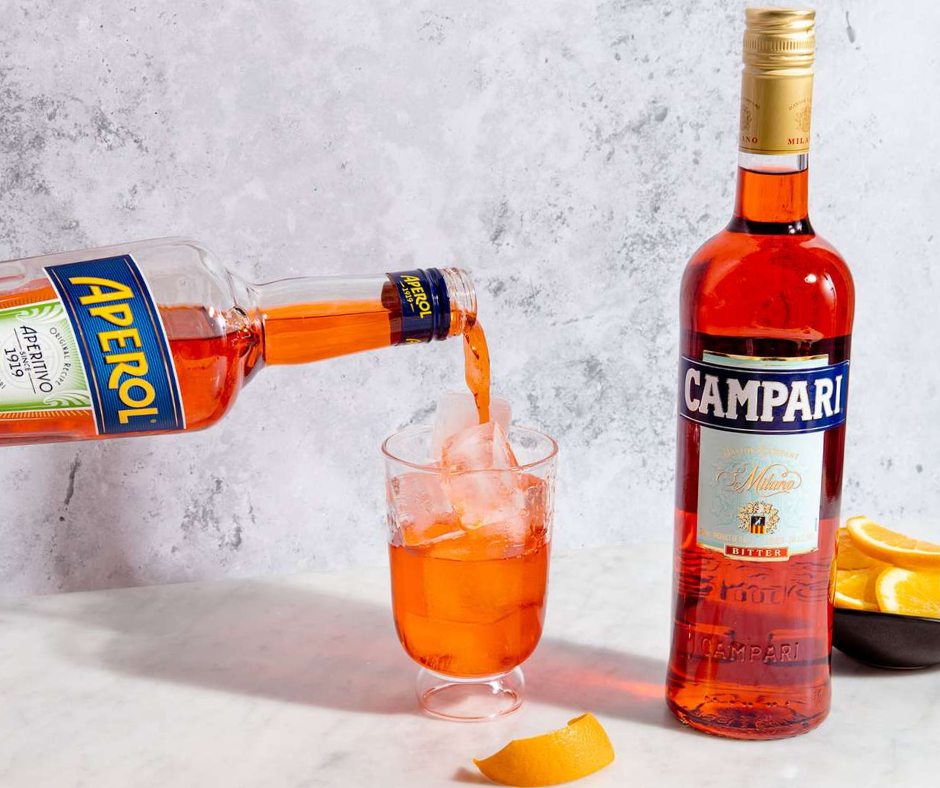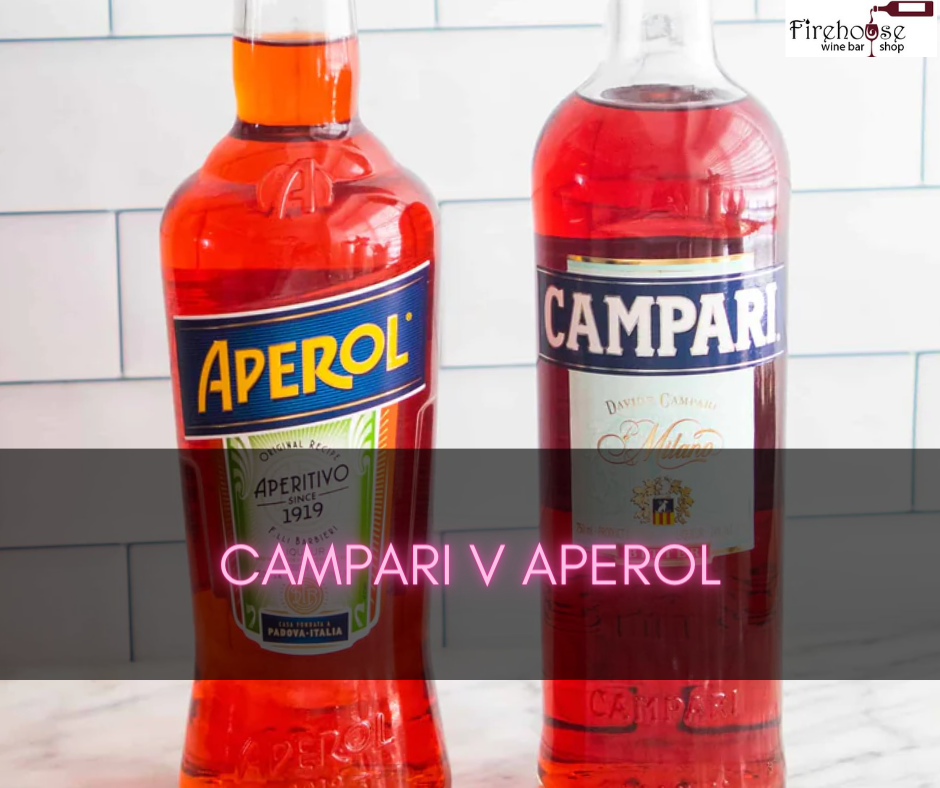Introduction
Campari and Aperol are two Italian liqueurs that have recently become increasingly popular. While they share some similarities, such as being owned by the Campari Group, their differences are crucial in determining how to use them in drinks. This article will overview Campari v Aperol and explore their origins and unique qualities.
Overview Of Campari And Aperol And Their Popularity In Cocktails
Campari and Aperol fall under the Italian aperitifs, bittersweet liqueurs meant to be consumed before a meal. They are often used as cocktail mixers to add depth and complexity to the flavor profile. These liqueurs have enjoyed a surge in popularity in recent years, especially in trendy and craft cocktail bars.
History And Origins Of Both Aperitifs
Campari was first created by Gaspare Campari in 1860. The recipe for this liqueur remains a closely guarded secret. However, it is known to be made from a blend of herbs, spices, and fruits, including bitter orange, rhubarb, and ginseng. Its distinct flavor and bright red color have made it a popular ingredient in cocktails such as the Negroni and the Americano.
On the other hand, Aperol was first produced in 1919 by the Barbieri brothers. Originally marketed as a health tonic, Aperol’s recipe includes bitter and sweet oranges, rhubarb, gentian, and cinchona. It is known for its vibrant orange color and slightly sweeter taste. Aperol gained widespread popularity in the 1950s and 1960s but experienced a resurgence in recent years as the signature ingredient in the Aperol Spritz.
In conclusion, Campari and Aperol are two Italian liqueurs that have become staples in the world of mixology. While they share some similarities, their unique qualities make them distinct and important ingredients in various cocktails.

What Is Campari?
History And Production Process Of Campari
Campari was first created in 1860 by Gaspare Campari, although the recipe remains a closely guarded secret. It is made from a blend of herbs, spices, and fruits, including bitter orange, rhubarb, and ginseng. The production process involves macerating the ingredients in a neutral alcohol before adding water and sugar. It is then aged for several months in barrels before bottling.
Taste Profile And Ingredients Of Campari
Campari’s distinct flavor comes from its multiple botanical ingredients and has a bright red color. It has a complex bitter and sweet taste and is often used as a mixer in cocktails such as Negroni, Boulevardier, and Americano. It has an alcohol content of 24% – 28.5% and a syrupy consistency that coats the tongue.
In conclusion, Campari is a beloved Italian liqueur with a rich history and unique flavor profile. Its blend of herbs, spices, and fruits has made it a popular ingredient in cocktails, though it is also commonly consumed neat or on the rocks.
What Is Aperol?
History And Production Process Of Aperol
Aperol was created in 1919 by brothers Luigi and Silvio Barbieri. It is made from a unique blend of bitter and sweet oranges, rhubarb, and gentian root. The ingredients are macerated in neutral alcohol and then blended with sugar and water. Aperol is aged for a short time in barrels before it is bottled.
Taste Profile And Ingredients Of Aperol
Aperol has a bright orange color and a sweet, slightly bitter taste with hints of citrus. It has an alcohol content of 11% and a light consistency. Aperol is often used in cocktails such as the Aperol Spritz, made with Aperol, prosecco, and soda water.
In conclusion, Campari and Aperol may seem similar at first glance, but they have distinctive differences in taste and production. Understanding these differences can help you choose the best liqueur for your cocktails.
Campari v Aperol
Campari and Aperol are two Italian liqueurs with many similarities but also key differences. Here are some of the main differences when comparing Campari v Aperol:
ABV, Bitterness, And Sweetness Comparison
Campari has a higher ABV (alcohol by volume) than Aperol, with an ABV of 24% – 28.5% compared to Aperol’s 11%. Campari is also significantly more bitter than Aperol, while Aperol tastes sweeter.
How To Use Campari And Aperol In Cocktails
While both Campari and Aperol can be used in various cocktails, they are usually used for different purposes. Bartenders often reach for Campari to add depth, body, bitterness, and a bit of sweetness to a cocktail. On the other hand, Aperol is a lighter, sweeter alternative that can add a touch of fruitiness and a mildly bitter note to drinks.
Some classic cocktails that use Campari include the Negroni, the Boulevardier, and the Campari and soda, while Aperol is most commonly used in the Aperol Spritz and the Aperol Sour. However, both liqueurs can be used in various other drinks depending on the individual bartender’s preferences.
Understanding the differences between Campari and Aperol can help you choose the right liqueur for a particular cocktail. While they may seem similar at first glance, each has its unique flavor profile and characteristics that make it ideal for specific drinks.

The Negroni Cocktail
The Negroni is a classic Italian cocktail that has existed since the early 20th century. It is made with equal parts gin, sweet vermouth, and Campari and is usually garnished with an orange peel. The drink is known for its bold, bitter flavor and deep red color.
History And Recipe Of The Negroni Cocktail
The Negroni cocktail was invented in Florence, Italy, in the early 20th century. The exact origin story of the cocktail is unclear. Still, it is believed to have been created by Count Camillo Negroni, who asked his bartender to make a stronger version of the Americano cocktail by replacing the soda water with gin.
You will need equal gin, sweet vermouth, and Campari to make a Negroni cocktail. Stir the ingredients with ice and strain them into a chilled glass. Garnish the drink with an orange peel.
Role Of Campari And Aperol In The Negroni
Campari and Aperol can be used in the Negroni cocktail, but they will give the drink different flavor profiles. Campari is known for its bitter taste, so using it in the Negroni will give the drink a bold, bitter flavor. On the other hand, Aperol is milder and sweeter, so using it in the Negroni will give the drink a lighter, fruitier taste.
When choosing between Campari and Aperol for your Negroni cocktail, it’s important to consider your taste preferences. Campari may be the better choice if you enjoy bold, bitter flavors. However, if you prefer a sweeter, more refreshing drink, Aperol may be the way to go.
In conclusion, the Negroni cocktail is a classic Italian drink enjoyed for over a century. Whether you choose Campari or Aperol in your cocktail, the key is finding the perfect ingredients to suit your taste.
Aperol: The Milder Contender
Unique Characteristics And Flavor Profile Of Aperol
Aperol is a popular Italian aperitif that has gained a reputation for being Campari’s milder, more approachable counterpart. It has a lower alcohol content and a sweeter taste, with prominent orange, rhubarb, and herbal notes. Compared to Campari, Aperol is less bitter and has a lighter, brighter color. These unique characteristics make Aperol a versatile ingredient in cocktails, as it can add a subtle sweetness and complexity without overpowering the other flavors.
Ideal Cocktails To Use Aperol In
Aperol’s flavor profile lends itself well to various cocktails, particularly those that require a delicate balance between different ingredients. One of the most popular cocktails to use Aperol is the Aperol Spritz, made with Prosecco, soda water, and an orange slice. The Aperol adds a sweet and slightly bitter taste to the cocktail, balancing out the acidity of the Prosecco. Another popular option is the Aperol Sour, which combines Aperol with lemon juice, simple syrup, and an egg white for a refreshing, bubbly drink.
Aside from these classics, Aperol can also be used in more creative cocktails such as the Paper Plane, which blends equal parts Aperol, bourbon, Amaro Nonino, and lemon juice, or in a twist on the Negroni called the Garibaldi, which substitutes Campari with Aperol and adds fresh orange juice. The possibilities are endless with Aperol, making it a staple in any home bar.
In conclusion, while Campari and Aperol may share some similarities in their role as Italian aperitifs, they offer distinct flavor profiles that cater to different tastes and preferences. Aperol’s mildness and versatility make it an ideal component in various cocktails, and its popularity is a testament to its status as a beloved component of the Italian drinking culture.

Campari: The Bold Contender
Unique Characteristics And Flavor Profile Of Campari
Campari is a bitter Italian liqueur that has a distinct and bold flavor. It is made by infusing a combination of herbs and spices with alcohol, resulting in a full-bodied taste. Campari’s bitter taste is derived from adding chinotto, a bitter orange variety, which gives it its signature flavor profile. Along with the bitterness, Campari has notes of cherry and cinnamon, making it complex and layered.
Ideal Cocktails To Use Campari In
Campari’s bold flavor makes it a popular component in various cocktails. One of the most iconic cocktails that features Campari is the Negroni, made with equal parts gin, sweet vermouth, and Campari. The Negroni perfectly balances the floral and herbaceous notes of gin with the bitter intensity of Campari, creating a perfect aperitif cocktail.
Another popular cocktail that highlights Campari’s flavor is the Americano, made with Campari, sweet vermouth, and soda water. Campari also works well in cocktails that call for orange juice, such as the Italian classic, the Campari, and Orange.
Campari’s complex flavor profile also makes it an ideal choice for more complicated cocktails. For example, the Boulevardier is made with bourbon, sweet vermouth, and Campari, while the Jungle Bird adds pineapple juice and blackstrap rum.
In summary, while Campari and Aperol are beloved Italian aperitifs, they offer distinct flavor profiles and use cases. Campari’s bitterness and complexity make it more suited to bold and complex cocktails, while Aperol’s sweetness and versatility work well in a wider variety of drinks. Regardless of personal preferences, any cocktail enthusiast should have both Campari and Aperol in their home bar.
Campari v Aperol: Which Is Better?
Comparison Of Taste Profiles, Versatility, And Popularity
Campari and Aperol are popular and versatile Italian aperitifs used in a wide range of cocktails. However, they differ significantly in taste profiles, versatility, and popularity.
Campari has a distinct bitter taste from adding chinotto, a bitter orange variety. It also has notes of cherry and cinnamon, making it complex and layered. On the other hand, Aperol is sweeter and less bitter than Campari, with distinct flavors of orange and rhubarb. Aperol is more versatile and can be used in a wider range of drinks, from spritzes to punches.
In terms of popularity, both Campari and Aperol have a dedicated following. However, Campari is more popular than Aperol in classic cocktails such as the Negroni and Americano. On the other hand, Aperol is more popular in modern drinks such as the Aperol Spritz.
Personal Preferences And Ways To Enjoy Campari And Aperol
Regarding personal preferences and ways to enjoy Campari and Aperol, it ultimately comes down to individual tastes. Some people may prefer the bold bitterness of Campari in cocktails like Negronis and Boulevardiers. In contrast, others may prefer the sweetness of Aperol in cocktails like the Aperol Spritz or Aperol Sour.
Campari and Aperol have a place in any home bar and can be used to create a wide range of creative and delicious cocktails. Experiment with both and find the perfect balance of bitter and sweet that suits your taste buds best.
Conclusion
Wrap-up Of Campari v Aperol Showdown
Now, you should know the comparison of Campari v Aperol. Campari and Aperol are delicious Italian aperitifs with unique qualities and characteristics. Campari is complex and layered, while Aperol is more versatile and sweet. Both have a significant following and can be enjoyed in a wide range of cocktails.
Final Thoughts And Recommendations
If you’re a bitter flavor fan, you should try Campari, while those new to Italian aperitifs should start with Aperol. However, it is always good to experiment with both to find out which suits your taste buds the best. With that said, both Campari and Aperol add an extra layer of flavor to cocktails, making them must-haves for any home bar.
FAQ: Campari v Aperol: Bitter Battle: Campari vs Aperol Showdown
Q: What is the difference when comparing Campari v Aperol?
A: The main difference between Campari and Aperol lies in their taste profile and alcohol content. Aperol is sweeter and less bitter than Campari, with an alcohol content around 11%. In contrast, Campari has a more bitter taste and a higher alcohol content of around 24%.
Q: Which one is better for beginners, Aperol or Campari?
A: Aperol is often a better option for beginners due to its sweeter taste and lower alcohol content. It is a good starting point for those unfamiliar with the strong and bitter flavors of typical Italian aperitifs.
Q: Can I substitute Campari with Aperol in a cocktail recipe?
A: You can substitute Campari with Aperol in a cocktail recipe. However, it is important to note that this will change the overall taste profile of the cocktail. Aperol will add a sweeter and less bitter taste, while Campari will add more bitterness to the drink.
Q: Which is better for a refreshing summer drink, Campari or Aperol?
A: Aperol is often the preferred choice for refreshing summer drinks due to its lower alcohol content and sweeter taste. Drinks like Aperol Spritz or Lemonade are perfect for sipping on a hot summer day. However, Campari can also be used in refreshing cocktails such as Negroni Sbagliato, which includes Campari, Prosecco, and soda water.
Q: Does the same company own Campari and Aperol?
A: Yes, the Campari Group owns both Campari and Aperol. Despite their differences, they share a common Italian heritage and are often used in similar cocktail recipes.

Andre Lotz immigrated to the United States from South Africa almost 20 years ago. Still, he didn’t feel truly at home until he settled in Mobile—a city that reminds him of his childhood home of Fish Hoek on the southern cape of Africa.

